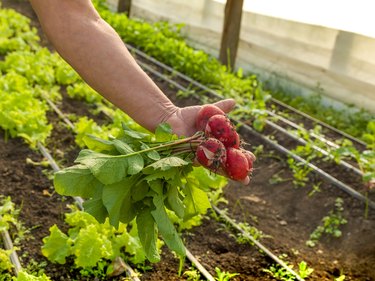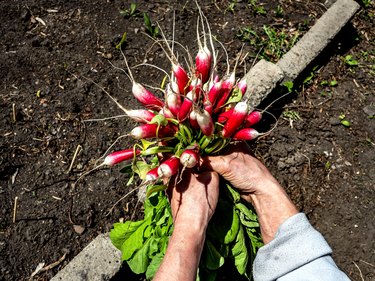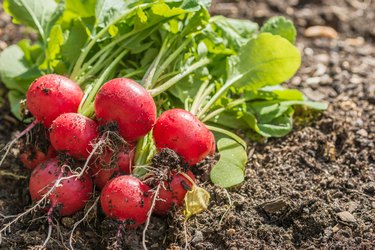
The crunchy roots of radishes (Raphanus sativus) add a dash of peppery flavor to salads, soups and other dishes. While the round or oblong roots are the best-known edible element, other parts of a radish plant are also tasty treats. Most radishes grown in home gardens are the short-lived annuals that are ready to harvest in three to four weeks, though the daikon radishes (Raphanus sativus var. longipinnatus) can overwinter in U.S. Department of Agriculture plant hardiness zones 9 through 11 and produce flowers and seeds the following year.
Annual Radish Variety
Video of the Day
The familiar spring or summer radishes, planted in early spring and harvested at three to six weeks, may be found in round or oblong roots ranging from red to purple to white with crunchy interiors. These annual root vegetables are generally used in salads and sandwiches. If allowed to grow in the garden, the plants will "bolt" or develop flowers and seeds. At that point, the roots have become woody and bitter.
Video of the Day
Biennial Daikon Radish
The large, long or round roots of the winter or daikon radish develop over two or more months. A cool season crop, the foliage and roots die at 25 and 20 degrees Fahrenheit, respectively. When planted in early fall and allowed to grow through the mild winters of USDA zones 9 and above, the plants will produce flowers and seeds in spring and early summer. Daikons are also used in colder climates as a green fertilizer and weed control; the plants grow quickly to crowd out weeds, then the leaves and roots die and decompose to provide both nutrients and organic matter.

Daikon radishes are usually harvested in 60 to 70 days, before the roots become pithy. While most are harvested in 40 to 70 days, depending on the cultivar, the roots continue to grow if not harvested. One of the largest of the daikons, 'Sakurajima Giant' may reach up to 100 pounds if left in the garden over the winter.
Root Sizes and Shapes
The primary food source for humans is the root of a radish. Specialized structures that store energy for the plant, they grow from small globes to huge, round, oblong or tapered roots. The thick roots have tiny feeder roots that reach into the soil around the main root to absorb water and nutrients.
The peppery flavor in radish roots and leaves comes from the glucosinolates, myrosinases and/or isothiocyanates produced by the plants. Wear gloves when harvesting leaves and roots; sensitive individuals may suffer from skin irritation.
Leaves and Stems
After the seeds germinate, the tiny leaves and stems emerge from the soil. Radish leaves grow in a rosette, rising above the soil. Like other plants, the leaves absorb the sunlight and store the energy produced in their roots. While radishes prefer full sun, they tolerate light or dappled shade.
Tender when young, you can enjoy the seedlings on salads or in sandwiches. Some gardeners grow radishes for their sprouts, much like mung beans (Vigna radiata). As the radish grows larger, you can cut a few leaves from each plant or trim the entire bunch from the harvested roots. Wash and cook like other greens or use in soups and stews.
Flowers and Seeds

Annual and biennial radishes produce flowers and seeds when they reach maturity. Hot weather speeds this process. The flowers and resulting seed pods are also edible. Once dried, the seeds can be used as a garnish.
The rat-tail or green radish (Raphanus sativus var. caudatus) is grown specifically for the large, green seed pods. It doesn't produce thick roots like other radishes. It grows up to 5 feet tall and 1 foot wide; harvest the young, tender seed pods at approximately five weeks. Enjoy them fresh, steamed, boiled, fried or pickled.